Abstract
Colombia has hundreds of historical shipwrecks, but systematic research on this topic is scarce, which makes locating wreck sites problematic. Colombia is home to the Caribbean archipelago of San Andres, Old Providence, and Santa Catalina. Its complex environmental conditions make it a “ship trap”. On 2 February 1894, the USS Kearsarge ran aground on Roncador Cay, one of the Archipelago’s islets, and the location of the wreck site remains uncertain. Due to its role in the American Civil War, the Kearsarge is important naval heritage. Based on historical and cartographic records, orthophotographs, Landsat images, and light-detection-and-ranging (LiDAR) data, this study aimed to estimate the location of the wreck site in a Geographic Information System (GIS). Court-martial records, particularly nautical data and astronomical coordinates, were reviewed, including a study from 1894 indicating the wreck’s location on a map without coordinates. Nautical charts were also analyzed to find the Kearsarge wreck symbol. To identify the wreck site’s ordnance, logbooks and information on previous salvage efforts were examined. The analysis of nautical charts revealed a few shipwrecks, but not the Kearsarge. Historical and remote-sensing data were processed in a GIS, along with the most recent nautical chart of Roncador Cay from 2017, to obtain a possible geographical location. This resulted in coordinates, which were used to detect features associated with the USS Kearsarge in the processed data. Although the wreck was not detected, the data helped to estimate the approximate coordinates for where the wreck could be located, quantifying our degree of uncertainty.
1. Introduction
Worldwide estimates place the number of shipwrecks at over three million, containing invaluable information about previous societies [1]. The process of shipwreck identification can be accomplished using a number of methods, with varying degrees of success [2,3]. Although the Caribbean Sea is rich in underwater cultural heritage [4], and Colombia has hundreds of historical shipwrecks [5], systematic studies are scarce, making it challenging to locate wreck sites [6]. This comparative dearth of research may be attributable to the geographic isolation of sites and Colombia’s underwater-cultural-heritage law [7]. The country’s location in the northwest corner of South America, near the isthmus and south of the Caribbean Sea, makes it a unique place [8,9]. Colombia’s maritime domain includes the western Caribbean archipelago of San Andres, Old Providence, and Santa Catalina (ASPSC) [10]. This area’s active maritime past can be attributed to the fact that it lies on key sea routes for colonial powers such as Spain and Britain and, later, the United States [11,12,13,14]. Its environmental conditions made it problematic in terms of navigation [15]. Extreme weather events [16] and a complex geomorphology characterize the archipelago [17,18]. With hundreds of shipwrecks in its waters, it has been termed a “ship trap”; however, it has received limited attention [6]. Roncador Cay is one of the banks and islets comprising the archipelago, where the United States Ship (USS) Kearsarge ran aground on 2 February 1894, sailing from Haiti to Nicaragua to protect “American interests” [19,20]. The vessel has a significant heritage regarding American naval history, due to its role in the American Civil War and its 1864 engagement with the Confederate State Ship (CSS) Alabama [21,22]. Nonetheless, the USS Kearsarge was largely forgotten until the end of the twentieth century, when technological advances enabled access to wreck sites and the US Navy recognized the significance of the remains [23,24,25].
Due to the confidentiality of underwater heritage in Colombian waters, enforced by the Submerged Cultural Heritage Law 1675 of 2013 [26], particularly regarding sunken warships, and Roncador Cay’s isolation, it is near impossible to conduct any survey at the sight. These factors make it essential to develop alternative research approaches. In this context, the study aimed to estimate the possible location of the USS Kearsarge using different methodologies, including, but not limited to, those based on historical and cartographic records, orthophotographs, Landsat images, and LiDAR data. To help estimate the location of the shipwreck, court-martial records, particularly nautical data and astronomical coordinates, were examined. Logbooks and salvage efforts were analyzed to trace and establish the ordnance at the wreck site. Historical and remote-sensing data were processed in a Geographical Information System (GIS) using a non-coordinates-system map of an 1894 accident study and georeferenced in a nautical chart from 2017 of Roncador Cay to obtain coordinates. Additionally, a review of Colombian, American, and British nautical charts from 1894 to 2022 was conducted to identify wreck symbols associated with the Kearsarge. Shipwrecks have been depicted in detail on nautical charts since 1830, providing critical information about wreck locations [27]. The 1894 celestial-navigation coordinates from the court martial and the coordinates obtained from the 1894 study were interpreted on the most recent chart based on historical information, and the depth reported in the shipwreck to select the most suitable coordinates. These coordinates define a geographical area that is used to detect shapes related to the wreck or artifacts, such as the ordnance. This location is a potential area in which the wreck could possibly be located.
2. The USS Kearsarge Characteristics
The USS Kearsarge was a Mohican-class sloop-of-war, launched in 1861 and designed by William L. Hanscom. The Kearsarge was one of the last few “old wooden” ships that remained in the US Navy, primarily due to its value and actions during the Civil War against the CSS Alabama in Cherbourg, France, in 1864 [22]. The Kearsarge was a three-masted steamship that could reach speeds of over 11 knots; it carried seven guns and 166 men, including officers. The machinery was a two-cylinder, horizontal, back-acting engine with a diameter of 54 inches and a stroke of 30 inches, with 822 horsepower [28] (Table 1). To provide a complete description, the USS Kearsarge is depicted from distinct angles in the plans from the 1888 shipyard period (Figure 1, Figure 2 and Figure 3).

Table 1.
USS Kearsarge (1861).

Figure 1.
Plan for the USS Kearsarge-79-9-34F. Navy Yard, Portsmouth, NY. December 1888 (National Archives at College Park).

Figure 2.
Plan for the USS Kearsarge-79-9-34E. Navy Yard, Portsmouth, NY. December 1888 (National Archives at College Park).

Figure 3.
Plan for the USS Kearsarge-79-9-34D. Navy Yard, Portsmouth, NY. December 1888 (National Archives at College Park).
Ordnance of the USS Kearsarge at Roncador Cay
To determine the ordnance at the wreck site, the study analyzed extensive data from logbooks and ship plans, tracing the most recent naval-weaponry changes. The interpretation of nineteenth-century logbooks, with the aim of detecting changes, presented a significant challenge, due to the ambiguous information [29]. However, the logbook data from 1888 to 1894 [30] were cross-referenced with the 1888 Brooklyn shipyard plans (numbers 79-9-34-D and 79-9-34-E) (Figure 2 and Figure 3). From the shipyard period of 1888/1889 to the shipwreck, the Kearsarge maintained the same ordnance. It was armed on deck with two 8-inch rifles converted from XI-inch Dahlgren shell guns (converted by insertion to 8-inch rifles) (Figure 4) and four IX-inch Dahlgren shell guns (Figure 5) [30,31]. Additionally, a 60-pounder rifle was in the forecastle (see Table 2).
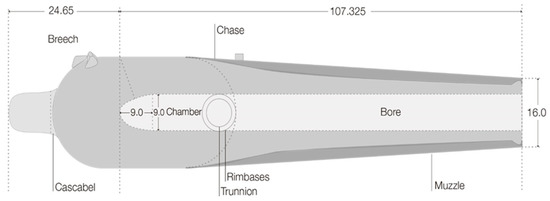
Figure 4.
IX-inch Dahlgren shell gun (measurements are in inches). Own elaboration, based on [31].
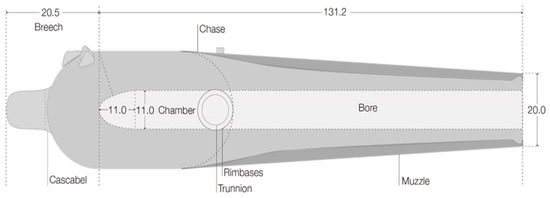
Figure 5.
An 8-inch Dahlgren shell gun (measurements are in inches). Own elaboration, based on [31].

Table 2.
Ordnance details during the shipwreck in 1894.
The “Dahlgren” guns IX, X, and XI were designed in 1854 by Admiral John Dahlgren, known as the “father of American naval ordnance” [32]. These were mostly made from cast iron in the Fort Pitt and West Point foundries [31]. Dahlgren cannons feature a unique outer shape with a hemispherical form and a curvilinear reinforcer, earning them the nickname “soda-water bottles”. Dahlgren’s designs were unquestionably the most influential in nineteenth-century American naval ordnance [31].
3. The Wreck Event and the Roncador Cay
In an effort to create an interoceanic canal connecting the Atlantic and Pacific oceans, the United States (US) exerted influence over Central America and the Caribbean during the late nineteenth century [33,34]. Nicaragua, Panama, and Haiti, all strategically located, received particular attention, with military interventions [35]. The US military forces, particularly the Navy, were greatly influenced by Mahan’s strategic thinking and were instrumental in charting a new course for American foreign policy in this region [36]. Alfred Mahan was a US Navy officer, and historian who developed theories and strategies for sea control (command of the sea). He argued for naval supremacy, commerce, and sea power. His understanding of geopolitics helped shape American politics in the late nineteenth and early twentieth centuries [37,38].
These political intentions were supported by the North Atlantic Station, the primary naval force in the Caribbean at the time, which consisted of several warships led by captains and directed by a rear admiral. Its duty was to limit the capabilities and operations of great powers, as the dominating naval force in the region, due to the vital significance of the Caribbean [39]. To serve as the flagship for Admiral Oscar Stanton, the North Atlantic Station Commander, the USS Kearsarge was sent to Haiti at the end of 1893 under a new commanding officer, Oscar Heyerman [20]. On 30 January 1894, it was ordered to depart Port-au-Prince and sail to Bluefields, Nicaragua, to protect American interests. The Kearsarge sailed in favorable weather conditions (a moderate breeze from the northeast to the east, with a force of four and two knots and stable barometric pressure) with no extreme or climate-related occurrences. Despite the dangers ahead, Commander Heyerman changed the navigational route on 2 February in the morning to obtain a clear sight of Roncador Cay from the north side. After sunset on 2 February, at approximately 6:50 p.m., a lookout reported breakers to the port and starboard at a distance of about 300 yards. The USS Kearsarge struck a coral reef in Roncador Cay within seconds of receiving lookout information, at a speed that caused one of the IX-inch Dahlgren shells to misadjust. The crew made unsuccessful attempts to maneuver the ship out of the reef, including throwing one of the IX-inch guns overboard to minimize weight [40]. The following day, the crew settled on a nearby bank for a few days, before being rescued by the steamship City of Para and returned to the United States.
The officers of the Kearsarge were fully aware of the threats posed by the archipelago of San Andres, Old Providence, and Santa Catalina Islands [41]. These are a collection of tiny islets and banks in the western Caribbean that include two inhabited islands, Old Providence and San Andres [10,17]. The archipelago is considered a ship trap, due to its complex geomorphology which threatens mariners and has resulted in hundreds of shipwrecks [42,43]. To further explain this, between the sixteenth and early-eighteenth centuries, 119 shipwrecks, many of which occurred in the archipelago, were listed in the book Naufragios y Puertos Martimos en el Caribe Colombiano (Shipwrecks and Seaports in the Colombian Caribbean) [5]. A recent article identified 23 shipwrecks in Roncador Cay from the sixteenth to the early twentieth centuries [6].
Roncador is a part of this area, with a coral cay 400 m long and 150 m wide, as well as a bank 15 km long and seven kilometers wide [44,45,46] (Figure 6). The cay was given the name “Roncador” by Spanish seafarers who were inspired by the sound generated by a persistent wave, which is similar to snoring [47,48].
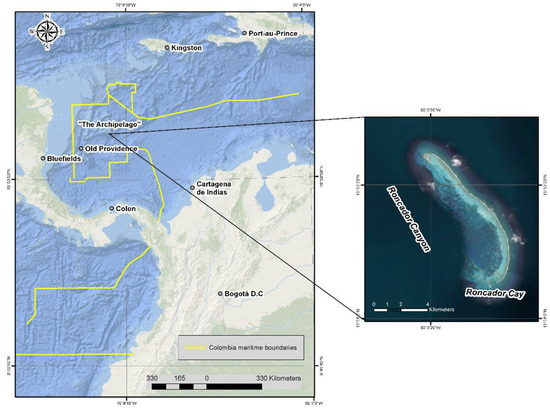
Figure 6.
Roncador Cay is located in the Caribbean archipelago of San Andres, Old Providence, and Santa Catalina Islands. The yellow line indicates Colombia’s maritime borders. Own elaboration.
Salvage Attempt
A few days after this, Admiral Herbert, Secretary of the Navy, submitted a letter to the Committee on Naval Affairs of the House of Representatives, underlining the significance of recovering such a historic ship and its ordnance [49,50]. Based on the inspection on 8 February 1894, the Secretary of the Navy indicated that the depth of the wreck (between 3 and 5 m) would permit the execution of rescue efforts. The United States Congress Committee on Naval Affairs passed the House Bill HR 5833, Rescue of the Armament and Wreck of the US War Ship Kearsarge [51], granting USD 45,000 for a successful rescue and just USD 10,000 in the event of a failure. The report argued for the salvage by highlighting the historical records of the USS Kearsarge and its encounter with the CSS Alabama on 11 June 1864, at Cherbourg, and stated that “it was felt that a portion of living American history had passed away” [51].
The contract was awarded to the Boston Towboat Company with the steamer Orion; however, given the history of marine accidents involving US Navy warships, success was unlikely. For example, on 1 January 1865, the USS San Jacinto ran aground on Cay No Name in the Bahamas, and was looted and burned after the copper was extracted [52]. Similarly, after running aground on Assateague Island, off the coast of Virginia, on 10 October 1891, the USS Despatch was completely looted [53]. The Orion arrived in Roncador on 22 March 1894, and found signs of destruction and looting of the USS Kearsarge [54,55]. The Kearsarge sustained partial damage from an explosion in the magazine by a fire caused by fishermen who were acting in haste to extract the copper from the hull. Although the wreckers attempted to remove the cannons, they were too heavy [56,57,58]. These practices were widespread among the Cayman-Islands and Old-Providence-Island fishermen, due to the prevalence of shipwrecks in the vicinity [59]. Later that year, the US Navy recovered a logbook, bell, Union Jack and bronze plaque commemorating the 1864 encounter with the CSS Alabama from Cayman Island [60,61]. The crew of the Orion captured some images of the wreck and its surroundings, which may be the first to depict the archipelago’s maritime landscape (Figure 7 and Figure 8).
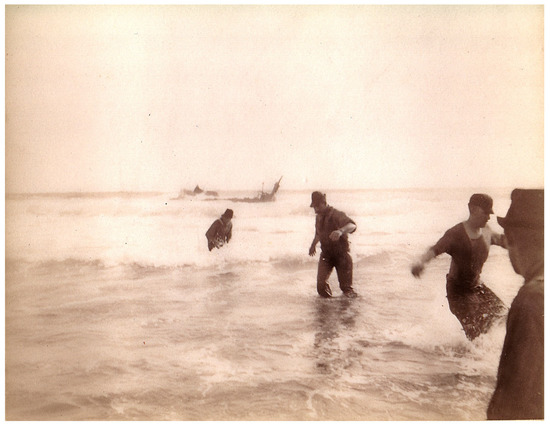
Figure 7.
The wreck of the USS Kearsarge in Roncador Cay, 1894. The image depicts the salvage attempts as well as the depth of the wreck, between three and five meters. Copy of the original image (photograph from Rich Schmidt’s personal archives).
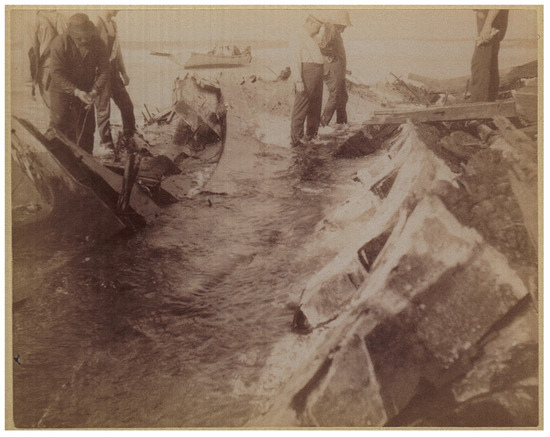
Figure 8.
On the deck of the USS Kearsarge, 1894. Copy of the original image (photograph from Rich Schmidt’s personal archives).
4. Environmental and Cultural Impacts of the Wreck
The remains of the USS Kearsarge were highly affected by looters and weather conditions. Roncador Cay is part of the Seaflower Biosphere Reserve, a protected marine area with a vast coral reef and favorable conditions for marine growth, which has embedded the remains [62]. The organic and inorganic artifacts at the wreck site have likely been impacted by the physical conditions of the ocean. Hurricanes and cold fronts are just two examples of extreme weather events in the area [18]. A tropical cyclone hit Roncador Cay a year after the shipwreck, which most likely had an impact on the wreckage, due to its shallow depth [63]. Climate change has also increased the frequency and intensity of storms. For example, hurricane Iota, a category-five tropical cyclone on the Saffir–Simpson scale, impacted the archipelago in 2020. Iota was the most powerful storm recorded in the archipelago in the previous 500 years [6,64,65]. However, the site’s isolation and status as a marine-protected area, with a coral-reef-conservation project managed by the local environment agency, means that there is limited anthropogenic influence at the wreck site [66].
5. Methodology
Estimating the location of the USS Kearsarge at Roncador Cay is problematic. Some reasons for this include the ambiguities arising from the nineteenth-century data, the confidentiality of information under Colombian underwater-heritage law [7], and the site’s isolation. However, research cases of wreck-site estimation were presented as “likely” locations on the basis of assumptions, as well as the scarcity and ambiguity of historical data. Furthermore, previous research revealed problems and difficulties in identifying and affiliating shipwrecks, due to ambiguous information [67], as well as the fact that wrecks tend to drift and often are not found in their expected location [68]. There are two notable shipwrecks whose estimated sites are in the Caribbean Sea. Phillips et al. [69] evaluated a possible location in which the Spanish galleon San Jose was lost in 1708 during the engagement between a British squadron, led by commodore Charles Wager, and a Spanish fleet, near Barú Island (Colombia). Her approach was based on assumptions and ambiguous evidence, including an approximated navigation derived from positions from the Wager fleet’s magnetic-compass records. The analysis included early-eighteenth-century British logbooks from Wager’s Action and the navigating practices of the time [69]. Similarly, Cazorla [69] evaluated primary sources and made assumptions to trace the final navigation of Christopher Columbus’ nao Santa Maria in 1492 to a likely site. She examined historical nautical charts, shoreline changes, and prior archeological surveys to reconstruct the navigation, and eventually approached Columbus’s estimated wreck location [70].
The potential location of the USS Kearsarge can only be estimated by considering alternative methodologies, due to the lack of international cooperation and the confidentiality of the Colombian law on submerged cultural heritage [26], as well as the remote location of Roncador Cay. Initially, nautical charts from 1894 to 2022 were examined, focusing on the area indicated by the celestial coordinates of 1894 during the actual shipwreck, to identify wreck symbols and locate the USS Kearsarge. Then, historical data and remote-sensing data were processed in GIS. A map of the wreck site (without coordinates), which was created by a study of the accidents in 1894 [41] was georeferenced on a nautical chart from 2017, of Roncador Cay, to determine the coordinates of the 1894 map. Additionally, the coordinates from the court-martial records were processed into a modern nautical chart. Based on historical information, the most appropriate coordinates were selected. To detect the shapes associated with remains or Dahlgren guns, these coordinates were used to superimpose digital aerial photography and a 3D-bathymetric model. The coordinates obtained are expected to serve as a geographical area of uncertainty, in which the USS Kearsarge could possibly be located.
6. Nautical Charts’ Wreck Validation
The purpose of nautical charts is to ensure safe navigation. They provide a physical description of seas, principally based on hydrography [71]. The extensive cultural heritage of nautical charts makes them a significant source of data on maritime history and nautical archaeology, meaning that they can be used to reconstruct the cultural landscape [72,73,74,75]. Analyzing nautical charts is one method of identifying and interpreting historical shipwrecks [15]. However, this approach is often ineffective in resolving the identity problem, because wrecks are deemed an obstruction to safe navigation, and only a small number of historical shipwrecks has reliably been recorded [76,77]. For the purpose of identification, wrecks are displayed as cautionary notes, and deployed on the chart with different symbols, using the international abbreviation “Wk”. According to the accident, the symbols for location and depth are distinct: stranded wrecks are portrayed by a hull rising from shallow water, while wrecks with masts display the inscription “Mast”. Shipwrecks of historical or cultural value are designated “Historic Wk” by the International Hydrographic Organization (IHO), and can be located on charts, with an explanation [78]. The United Kingdom Hydrographic Office (UKHO) has had a significant global impact on hydrography. By 1830, Captain Francis Beaufort had standardized features and relevant information for seafarers on nautical charts. He included information about sandbars, rocks, depths, navigational aids, shipwrecks, topography, and landmarks such as towers and churches [27]. The study of the HMS Thetis incident at Cabo Frio, Brazil, is one example of how historical nautical charts have been used to analyze a shipwreck [79].
The methodology centered on located wreck symbols at Roncador Cay after 1894, particularly in the area specified in the court martial. The data were collected from hydrographic agencies from the United Kingdom, the United States, and Colombia. For this purpose, the catalogue of admiralty charts in the UKHO archive was examined, focusing on the Admiralty Chart Series, Archive’s Old Copy Bundle (OCB), Series, 1800–2016. This archive is listed as one of the world’s most comprehensive collections of nautical documents [80]. Additionally, the National Archives and Records Administration (NARA), including the United States Hydrographic Office records, were examined. These include the Record Group 38: Records of the Office of the Chief of Naval Operations, 1875–2006 Series: Records Relating to Naval Strategy, 1915–1985 and Record Group 37: Records of the Hydrographic Office [81], in addition to the Preliminary Inventories No. 85 [82] and the United States Hydrographic Office Manuscript Charts in the National Archives, 1838–1908 [83]. Four agencies from Colombia were considered. First, records held by the maritime administration (DIMAR) from Rocandor Cay, entitled “Isla Cayos de Roncador” (Roncador Island), were examined [84]. The compilation of historical nautical charts by the Colombian Ocean Commission (CCO), published in the Atlas Histórico Maritimo de Colombia Siglo XVII (Historical Maritime Atlas of Colombia) [85], was analyzed. Finally, the Archivo General de la Nación (the Colombian central archive) and Biblioteca Luis Angel Arango (the country’s largest library) were consulted.
After reviewing data from these archives, some wrecks were discovered and located at Quitasueno, Serrana, Bajo Nuevo Banks, and Old Providence Island on different nautical charts (Figure 9 and Figure 10). However, a lack of information prevented the wrecks from being identified. Although the primary goal of locating the USS Kearsarge wreck symbol was not achieved, other wrecks in Roncador Cay and the surrounding area were discovered, although without details. Based on coordinates from 1894, the symbols are not located in the possible shipwreck area of the Kearsarge. The findings are summarized in Table 3, and are suitable for future research on shipwrecks in the archipelago.

Figure 9.
Extract from the chart OCB 1218 A22 West Indies, 1973 (UK Hydrographic Office). A wreck was noted south of Roncador Cay.
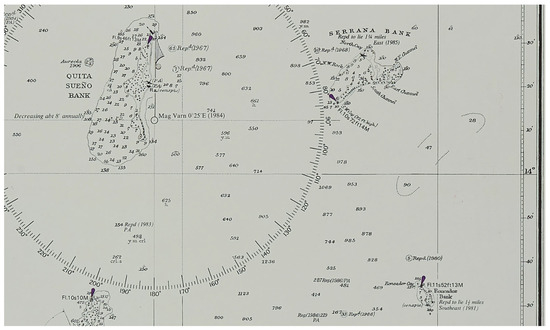
Figure 10.
Extract from the chart OCB 1218 A29 West Indies, 1987 (UK Hydrographic Office). A wreck was noted south of Roncador Cay in 1981, as well as other wrecks in the surrounding banks (Quitasueno and Serrana Banks).

Table 3.
Relationship between nautical charts of Roncador Cay for wreck-symbol validation.
7. Estimating the Location Using Historical and Remote-Sensing Data Analysis
Remote sensing has been used in shipwreck detection, particularly in shallow and coastal areas [86,87,88,89,90,91,92]. This research integrated an analysis of light-detection-and-ranging (LiDAR), aerial photography, satellite-imagery and bathymetric data. In addition, data analysis’ ability to recognize submerged features, geoforms, and landforms as inputs connected with shipwreck remains, artifacts or elements such as Dahlgren-guns shape was evaluated [91,93]. The application of this technology is constrained by the high cost of images or bathymetric data [94]. However, some data were available from open-access multispectral imagery, such as the data provided by the National Aeronautics and Space Administration (NASA), which operates the high-resolution satellite Landsat-8 [95]. The Colombian Navy and Air Force provided the additional data used in this study, which are not publicly available (LiDAR, aerial-photography and bathymetric data). In the case of Roncador Cay, its geographical isolation poses a particular challenge when estimating the wreck site, emphasizing the need for non-invasive techniques. The underwater clarity of the archipelago and the wreck’s depth (between three and five meters) are advantageous for detection. However, the physical conditions of the archipelago are unfavorable for the preservation of underwater remains in shallow waters [90].
Initially, to estimate and define a search area that can be used to analyze the images, coordinates were collected from the 1894 court martial, followed by the location depicted on a non-coordinate-system map of an 1894 accident study. During the court martial, the US Hydrographic Office (HO) and the US Navy Bureau of Navigation confirmed the geographic location, latitude, and longitude of Roncador Cay, at the south point. It was determined that the longitudes of Roncador Cay and other nearby locations depended on the chronometric measurements conducted by Captains Richard Owen and Edward Barnett in 1835, onboard the HMS Jackdaw and HMS Thunder, respectively, utilizing longitude observations from Port Royal, Jamaica [40]. However, the differences in specific charts demonstrate the relative imprecision and inaccuracy of hydrographic technology when establishing a position with coordinates.
The position calculated by the reciprocal bearings taken on 3 February 1894, from the USS Kearsarge and Roncador Cay, was displayed in court. The wreck site was situated by astronomical observations at latitude 13°34.3′ N and longitude 80°4.4′ W, which found the ship to be about E. 16° south (true) from the south point of Roncador Cay and about 7/10 of a mile from the edge of the reef [40].
The other coordinates originated from a study of Lieutenant Burns T. Walling, an officer onboard the USS Kearsarge at the time of the incident, who was assigned to write an account of the occurrence. The study was published in the Proceeding from the United States Naval Institute, a monthly journal, in October 1894. Burns [41] created a remarkable graphic representation of the wreck site by superimposing the location of the USS Kearsarge, denoted by the letter “A” on the British Survey L449 Roncador Bank chart from 1835, without a coordinate system (Figure 11). However, due to the low resolution of Plate I, a copy of the original nautical chart used in the study from a British survey was examined. The wreck point was identified in an area near a shoal marked as “sand” and “coral” with no soundings in this area, due to the shallow waters (Figure 12).
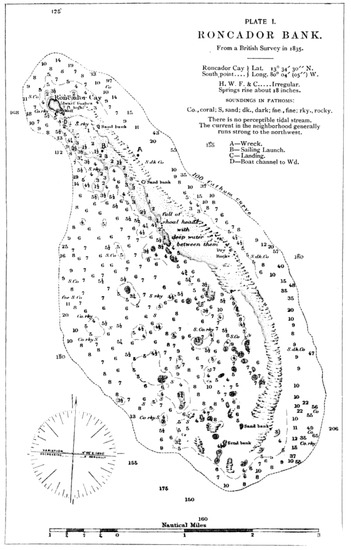
Figure 11.
Plate I from the 1894 study. Roncador Bank from a British Survey in 1835. The location of the wreck is marked with the letter A. This plate was processed in GIS [41].
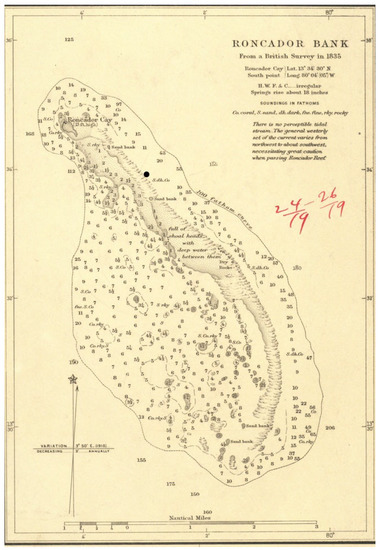
Figure 12.
Extract of Roncador Cay from the chart No 1374 (HO, 1893) (National Archives and Records Administration). The wreck point from the Plate I, was identified in an area near a shoal marked as “sand” and “coral”, with no soundings in this area due to the shallow waters (the wreck is indicated by a black point.).
In order to obtain coordinates for the wreck location, indicated by the letter “A”, the Plate I map was imported in a GIS. For this purposes, the plate was orthorectified using the most recent georeferenced chart of Roncador Cay: Carta No 211 Isla Cayos de Roncador 4ta. Ed. 2017 (DIMAR) (the nautical chart from Roncador, 2017). Four control points from the 2017 nautical chart were selected, based on the presence of detailed features (coral reef and the cay) (Figure 13). The coordinates obtained from the Plate I letter “A” are latitude 13°33′34,141″ N and longitude 80°4′11,546″ W. However, the nineteenth-century hydrographic techniques prevented us from determining the coordinates with any degree of precision.
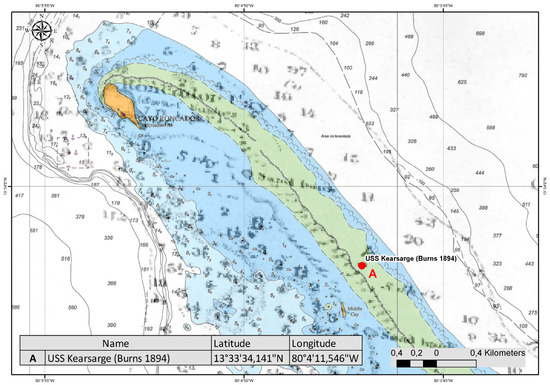
Figure 13.
Plate I was orthorectified using the chart of Roncador Cay, Carta No 211 Isla Cayos de Roncador 4ta. Ed.2017 (DIMAR) (the Nautical Chart from Roncador, 2017). Four control points from the 2017 nautical chart No 211 were selected, based on the presence of detailed features.
The remote-sensing data obtained from multiple sources for detecting the remains were processed using a single reference point, allowing for data superimposition (digital photographs, remote-sensor images, LiDAR, and bathymetry of the area) [96]. Following the national geodetic reference system, Marco Geocéntrico Nacional de Referencias (MAGNA, in Spanish) established by the Geographic Institute of Colombia (Agustín Codazzi) (IGAC) in 2005 [97], the data were digitally transformed to a single-horizontal-reference system: cartographic origin MAGNA Colombia West West -(4°35′46.3215″ N; 80°04′39.0285″ W). This conversion to MAGNA was accomplished using ArcGis 10.6.1, a specialized software for analyzing geographic data.
3D Bathymetric Model
To determine the depths of Roncador Cay, Landsat-8 images were digitally corrected and integrated with bathymetric data (Figure 14). This integration enabled the research to analyze submerged features or geoforms that could be associated with the remains, particularly the Dahlgren-gun shape.
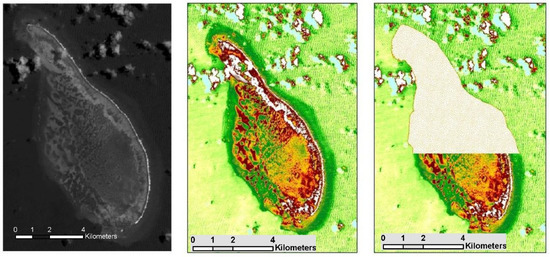
Figure 14.
Roncador Cay. The image on the left is a Landsat-8 without digital correction. The central image was corrected and integrated with bathymetric data. The right image depicts a polygon in Roncador Cay (beige color). Own elaboration.
The depth of the sub-littoral zone of the archipelago was determined by processing the Landsat ETM + image at level 2 (orthorectified)—path/row: 014/, from 26 July 2001, and IGAC-completed bathymetry data of 2014 (composed of isobaths from San Andres and Old Providence Island, as well as the banks and cays of Roncador, Serrana, Serranilla, Quitasueño, Alburquerque, and Bajo Nuevo), from images of IKONOS and Landsat remote sensors. The 2014-bathymetry data were loaded into ArcGis 10.6.1, using Roncador Cay for the 3D-bathymetric model (Arc Toolbox\3D analyst tools\data management\TIN\output TIN (output file name)—Coordinate Magna_Colombia_Oeste_Oeste\input feature) (filename to load). Based on Landsat images, this technique developed triangulated, irregular networks, enabling the creation of a 3D-bathymetric model (Figure 15). The model generated the bathymetry for Roncador Cay and digitally transformed it to the MAGNA West- Colombia cartographic-horizontal reference system.
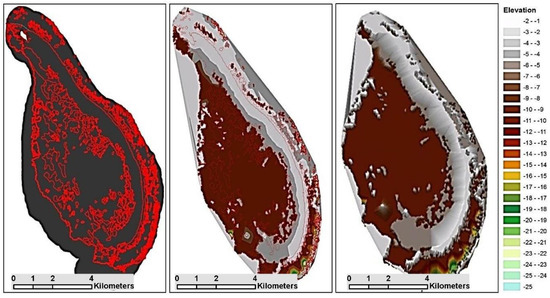
Figure 15.
Left image, bathymetry 2014 (IGAC) loaded in ArcGis 10.6.1. Central image, triangulated irregular networks. Right image, 3D Bathymetric Model in ArcScene 10.6.1. Own elaboration.
8. Discussion and Conclusions
The hydrographic and astronomical-observation data collected from the nineteenth century do not contain accurate information that can be used to determine the precise location of the wreck site. It is also not possible to reconstruct the navigation in a nautical chart and approach this location, due to the absence of logbook entries for the two days preceding the accident [30]. Consequently, it was necessary to integrate the historical data with the remote-sensing data, to determine an area of uncertainty for the wreck site. For this purpose, the astronomical-coordinate data and the coordinates obtained from the Plate I were established in a geographic-information system (ArcGIS), in nautical chart No 211 of 2017 (Figure 16).
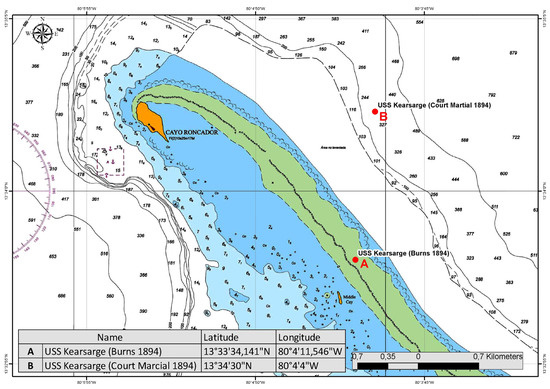
Figure 16.
The coordinate system obtained from the 1894-study map (Burns 1894) and the astronomical coordinates of the accident shipwreck (court martial) were set on nautical chart No 211 (DIMAR). Due to the lack of accuracy of navigation techniques in the nineteenth century, the astronomical coordinates were located outside of the reef. The differences between the coordinates are depicted in the table on the left side of the image.
Additionally, the coordinates obtained from Burns’s Plate I point “A”, as well as coordinates from the court martial, were assigned to a processed satellite image of Roncador Cay of 2020 (Figure 17).
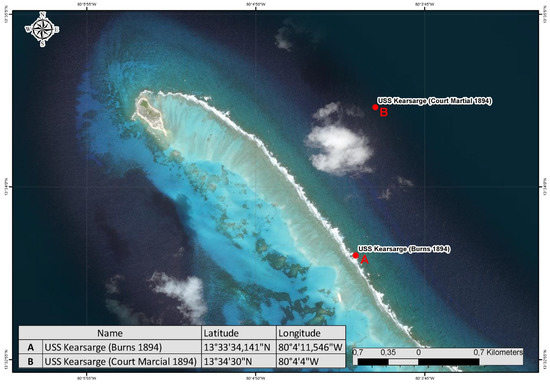
Figure 17.
WorldView-2 satellite image of Roncador Cay of 2020. The coordinate system obtained from the 1894-study map (Burns 1894) and the astronomical coordinates of the accident shipwreck (court martial) were set on the satellite image of Roncador Cay.
The USS Kearsarge ran aground close to the shoal at depths of approximately three and five meters, at the bow and stern, respectively, according to historical evidence from the court martial and the 1894 study. The astronomical coordinates were set outside of the reef and in deep waters, due to the lack of accuracy in the nineteenth century. Based on the shipwreck’s historical data, these coordinates were rejected as a potential location, and only those found on Plate I were accepted as a potential location. Although the estimated area (Figure 18) does not corroborate the exact location, it provides a limited-spatial area in which remote-sensing data can be applied to locate artifacts or remains from the wreck site. Additionally, these data can be helpful in further identification studies.
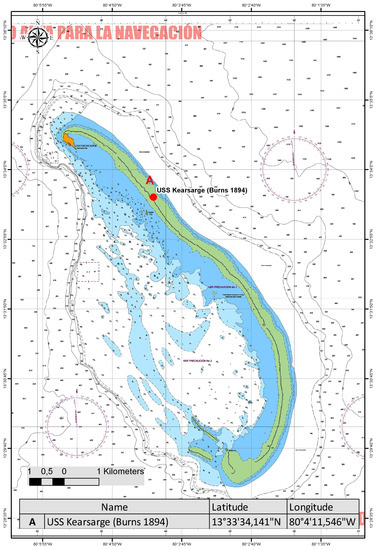
Figure 18.
Nautical chart No 211 of Roncador Cay, 2017 (DIMAR). The potential location in which the wreck could be located (red point) was determined using the coordinates obtained from the 1894-study map (Plate I).
Finally, the 3D-bathymetric model was superimposed on Landsat-8 data and digital aerial photographs, using the generated limited-spatial area (Figure 19). The images were processed to detect different shapes, patterns, colors, and textures that might be connected to the wreck or cylinder shapes associated with the Dahlgren guns, in shallow and clear waters. Furthermore, an analysis based on the ArcGIS software’s digital-terrain model was conducted, to generate perspective views and a terrain-slope map of Roncador Cay in the area of interest (Figure 20). However, identification was not possible, for two primary reasons. First, the low resolution of the images prevented the accurate identification of depth-related shapes. Despite the information regarding the depth of the wreck that was obtained from the court martial, suggesting it was between three and five meters, it was not feasible to locate relevant shapes. The second significant factor was the prevalence of coral reefs, which prevented identification.
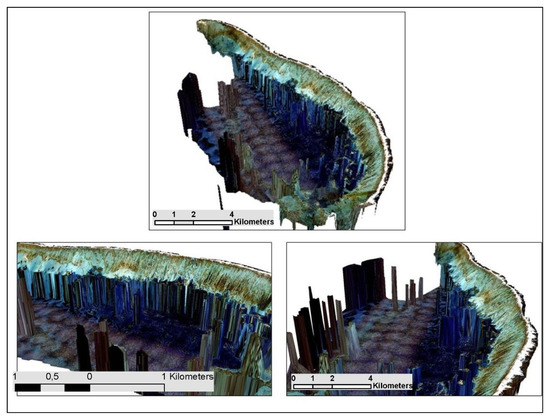
Figure 19.
Images from different observation points regarding the superposition of digital aerial photography and 3D-bathymetric model in Roncador Cay. The image above depicts the entire Cay. The right and left images corresponded to the area of the coordinates obtained from Plate I. These images have different angles and scales. Own elaboration.
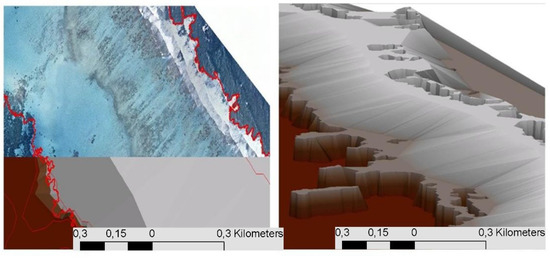
Figure 20.
Bathymetric-image visualization and a 3D-bathymetric model of Roncador are used to detect shapes associated with the shipwreck. The right and left images corresponded to the area of the coordinates obtained from Plate I. Own elaboration.
Although the processing of historical and remote-sensing data was unsuccessful in detecting shapes associated with the USS Kearsarge, the research generated coordinates in which the wreck could potentially be located. This coordinates were based on the data processed in GIS, in a georeferenced nautical chart of Roncador Cay from 2017. This result could be used to estimate the likely location of the remains of the USS Kearsarge. Despite its inaccuracy, this information is useful for future wreck-site surveys. The ordnance analysis derived from the logbooks and the most recent ship plans supplied reliable data. Additionally, the review of the salvage attempt contributed information concerning ordnance, with conclusive evidence demonstrating that the cannons could not be salvaged during the rescue attempts. Critical nautical information was analyzed from the court martial [40] to validate the wreck site by analyzing charts from 1894 to 2022. This methodology uncovered no evidence to support the Kearsarge-wreck-site hypothesis. However, some intriguing discoveries were found, including a lighthouse that began operations in 1920, and other wrecks from the twentieth and twenty-first centuries on banks and cays, although none of them could be identified. The research presents extensive evidence of shipwrecks in the archipelago of San Andres, Providence, and Santa Catalina, corroborating the designation of this area as a historical ship trap with hundreds of “hidden shipwrecks” in its waters. Finally, the presentation of this estimated location aims to protect the wreck site of this shared underwater cultural heritage between the United States and the natives of the archipelago.
Author Contributions
Conceptualization, methodology, validation, and resources W.G.P., A.C.D. and M.J.; writing—original draft preparation, and editing W.G.P., A.C.D. and M.J.; writing—review and editing, W.G.P., A.C.D. and M.J.; supervision, W.G.P., A.C.D. and M.J. All authors have read and agreed to the published version of the manuscript.
Funding
This research was funded by the Ministry of Education of the Republic of Korea and the National Research Foundation of Korea, grant number: NRF-2018S1A6A3A01081098.
Data Availability Statement
All data are available from the corresponding author on request.
Acknowledgments
We want to express our gratitude to the reviewers for devoting the necessary time and effort to the article. We greatly appreciate all of your valuable comments, suggestions, and recommendations, which enabled us to improve the quality of the article. We would like to thank Samuel Robinson, an Old-Providence-Island historian, for providing oral information about the archipelago. In addition, we thank Diego Mora in Washington DC for sharing NARA files during the COVID-19 pandemic, Rich Schmidt for his contribution of the original photos from the salvage attempt, and Erik Farrell from the Mariners’ Museum and Park for his contribution and information on the ordnance. Special thanks to the Colombian Air Force and Navy for providing remote-sensing data and aerial photographs.
Conflicts of Interest
The authors declare no conflict of interest.
References
- Koutsi, D.; Stratigea, A. Shipwrecks’ Underwater Mysteries—Identifying Commonalities Out of Globally-Distributed Knowledge. Heritage 2021, 4, 3949–3969. [Google Scholar] [CrossRef]
- Orser, C.E. Encyclopedia of Historical Archaeology, 1st ed.; Routledge: Abingdon-on-Thames, UK, 2002. [Google Scholar]
- Adams, J. A Maritime Archaeology of Ships: Innovation and Social Change in Medieval and Early Modern Europe; Oxbow: Oxford, UK, 2013. [Google Scholar]
- Leshikar-Denton, M.E. Problems and Progress in the Caribbean. In International Handbook of Underwater Archaeology. The Springer Series in Underwater Archaeology; Ruppé, C.V., Barstad, J.F., Eds.; Springer: Boston, MA, USA, 2002. [Google Scholar] [CrossRef]
- Romero, L.; Pérez, J.F. Naufragios y Puertos Marítimos en el Caribe Colombiano; Siglo XXI Editores: Mexico, D.F., México, 2005. [Google Scholar]
- Gomez Pretel, W.; Jeong, M.S. Shipwrecks on Roncador Cay, the Caribbean Sea and Their Relationship with Hurricanes, 1492–1920. Int. J. Histor. Archaeol. 2022, 26, 498–528. [Google Scholar] [CrossRef]
- Martín, J.G.; Pérez Díaz, J.F.; Gomez Pretel, W. Underwater Archaeology in Colombia: Between Commercial Salvage and Science. Int. J. Histor. Archaeol. 2022, 26, 457–473. [Google Scholar] [CrossRef]
- Gomez Pretel, W.; Castro, G. Colombian Navy and its contribution to the United Nations Forces in the Korean War (1951–1955). Cult. Interact. Stud. Sea Port Cities 2020, 23, 155–189. [Google Scholar] [CrossRef]
- Ramírez-Cabrales, F.; Pedroza, W.; Forero, J. Intereses Marítimos Colombianos; Serie Publicaciones Especiales CCO; Vicepresidencia de la República-Comisión Colombiana del Océano-Armada de Colombia; Comisión Colombiana del Océano: Bogotá, Colombia, 2021. [Google Scholar]
- DIMAR. Atlas Cartográfico de los Océanos y Costas de Colombia; Dirección General Marítima: Bogotá, Colombia, 2005. [Google Scholar]
- Lugo-Fernández, A.; Ball, D.A.; Gravois, M. Analysis of the Gulf of Mexico’s Veracruz-Havana Route of La Flota de la Nueva España. J. Marit. Archaeol. 2007, 2, 24–47. [Google Scholar] [CrossRef]
- Gomez Pretel, W.; Carvajal, A. Estrategia para la defensa y ubicación de las fortificaciones de la Plaza Fuerte de Cartagena de Indias en el Siglo XVIII: A partir de condiciones océano-atmósfera y variaciones morfológicas en la línea de costa. Saber Cienc. Y Lib. 2011, 6, 179–192. [Google Scholar] [CrossRef]
- Bassi, E. An Aqueous Territory: Sailor Geographies and New Granada’s Transimperial Greater Caribbean World; Duke University Press: Durham, NC, USA, 2016. [Google Scholar]
- Fajardo, S.; Hofstede, G.J.; de Vries, M.; Kramer, M.R.; Bernal, A. Gregarious behavior, human colonization and social differentiation: An agent-based model. J. Artif. Soc. Soc. Simul. 2020, 23, 1–11. [Google Scholar] [CrossRef]
- Peterson, M. History under the sea. In A Handbook for Underwater Exploration; Smithsonian Institution: Washington, DC, USA, 1965. [Google Scholar]
- Andrade, C.A.; Barton, E.D. Eddy development and motion in the Caribbean Sea. J. Geophys. Res. Ocean. 2000, 105, 26191–26201. [Google Scholar] [CrossRef]
- Coralina-Invemar. Atlas De La Reserva De Biósfera SeaFlower; Archipiélago de San Andrés, Providencia y Santa Catalina; Serie de Publicaciones Especiales de INVEMAR # 28; CORALINA: Santa Marta, Colombia, 2012. [Google Scholar]
- Ortiz-Royero, J.C.; Otero, L.J.; Restrepo, J.C.; Ruiz, J.; Cadena, M. Cold fronts in the Colombian Caribbean Sea and their relationship to extreme wave events. Nat. Hazards Earth Syst. Sci. 2013, 13, 2797–2804. [Google Scholar] [CrossRef]
- How the old “kearsarge” came to her ending. The Marine Journal, 7 February 1925; 6, 24–25.
- Gomez Pretel, W.; Jeong, M.S. Shipwreck in the Caribbean Sea: Analysis in the Loss of the U.S.S. Kearsarge-Roncador Cay, Colombia (1894). J. Mar. Isl. Cult. 2020, 9, 14–21. [Google Scholar] [CrossRef]
- Robinson, W. The Alabama-Kearsarge Battle. A Study in Original Sources. Historical Collections of the Essex Institute; Essex Institute: Salem, MA, USA, 1924; Volume LX, pp. 209–218. [Google Scholar]
- Marvel, W. The Alabama & the Kearsarge: The Sailor’s Civil War (Civil War America); The University of North Carolina Press: Chapel Hill, NC, USA, 2007. [Google Scholar]
- Dudley, W.S. American Naval Archaeology: Past and Prologue. Pull Together 1991, 30, 1–5. [Google Scholar]
- Dudley, W.S. The Historical Significance of Naval Archaeology; Paper presented at Historia Marítima y Naval Iberoamericana; Universidad Marítima de Chile: Viña del Mar, Chile, 1993. [Google Scholar]
- Dudley, W.S. American Naval archaeology: Past and prologue. In Maritime Archaeology: A Reader of Substantive and Theoretical Contributions; The Springer Series in Underwater Archaeology; Babits, L.E., Van Tilburg, H., Eds.; Springer: Boston, MA, USA, 1998; pp. 105–109. [Google Scholar] [CrossRef]
- 26. Diario Oficial de Colombia. Ley 1675 de 2013, por Medio de la Cual se Reglamentan los Artículos 63, 70 y 72 de la Constitución Política de Colombia en lo Relativo al Patrimonio Cultural Sumergido; Bogotá, República de Colombia: Bogotá, República de Colombia, 2013. [Google Scholar]
- National Library of Scotland. Admiralty Charts of Scottish Coasts, 1795–1963. Available online: https://maps.nls.uk/coasts/admiralty_charts_info.html (accessed on 22 February 2022).
- Canney, D. Volume One—Frigates, Sloops, and Gunboats, 1815–1885. In The Old Steam Navy; Naval Institute Press: Annapolis, MD, USA, 1990. [Google Scholar]
- Wheeler, D. Understanding seventeenth-century ships’ logbooks: An exercise in historical climatology. J. Marit. Res. 2004, 6, 21–36. [Google Scholar] [CrossRef]
- Department of the Navy, Office of the Secretary. Record Group 24: Records of the Bureau of Naval Personnel, 1798–2007 Series: Logbooks of U.S. Navy Ships, ca. 1801—1940; USS Kearsarge 1888–1894; File Unit: Washington, DC, USA.
- Olmstead, E.; Stark, W.E.; Tucker, S.C. The Big Guns: Civil War Siege, Seacoast and Naval Cannon; Museum Restoration Service: Bloomfield, ON, Canada, 1997. [Google Scholar]
- Johnson, W. Admiral John AB Dahlgren (1809–1870): His life, times and technical work in US naval ordnance. Int. J. Impact Eng. 1989, 8, 355–387. [Google Scholar] [CrossRef]
- Frenkel, S. Jungle stories: North American representations of tropical Panama. Geogr. Rev. 1996, 86, 317–333. [Google Scholar] [CrossRef]
- Grenville, J.A. Diplomacy and War Plans in the United States, 1890–19171. Trans. R. Hist. Soc. 1961, 11, 1–21. [Google Scholar] [CrossRef]
- Castor, S.; Garafola, L. The American Occupation of Haiti (1915-34) and the Dominican Republic (1916-24). Mass. Rev. 1974, 15, 253–275. [Google Scholar]
- Clayton, L. The Nicaragua Canal in the Nineteenth Century: Prelude to American Empire in the Caribbean. J. Lat. Am. Stud. 1987, 19, 323–352. [Google Scholar] [CrossRef]
- Mahan, A.T. The Interest of America in Sea Power, Present and Future; Little, Brown: Boston, MA, USA, 1917. [Google Scholar]
- Sumida, J. Alfred Thayer Mahan, Geopolitician. J. Strateg. Stud. 1999, 2, 39–62. [Google Scholar] [CrossRef]
- Rentfrow, J.C. The Squadron Under Your Command: Change and the Construction of Identity in the US Navy’s North Atlantic Squadron, 1874–1897. Ph.D. Thesis, University of Maryland, College Park, MD, USA, 2012. [Google Scholar]
- Kelley, J. Record of the Proceeding of a Court of Inquiry, Order by the Secretary of the Navy, to Investigate the Loss of the US; Ship Kearsarge; Held at the Navy Yard, New York. N. Y, February 26, 1894.Court Martial Records, Vol 550, No 4854. Court of inquiry loss of the USS Kearsarge, 1894. Record group, 125; National Archives Building: Washington, DC, USA, 1984. [Google Scholar]
- Burns, W. The Wreck of the Kearsarge: A Narrative. Proceeding US Nav. Inst. 1894, 4, 672–690. [Google Scholar]
- Serrano-Mangas, F. Naufragios y Rescates en el Tráfico Indiano Durante el siglo XVII; Sociedad Estatal Quinto Centenario; Ediciones Siruela, S.A: Madrid, España, 1991. [Google Scholar]
- Gould, R.A. Archaeology and the Social History of Ships, 2nd ed.; Cambridge University Press: Cambridge, UK, 2011. [Google Scholar]
- Geister, J.; Díaz, J.M. Reef Environments and Geology of an Oceanic Archipelago: San Andres, Old Providence and Sta. Catalina (Caribbean Sea, Colombia); Boletín Geológico Instituto Nacional de Investigaciones Geológico Mineras: Bogotá, Colombia, 2007; Volume 232. [Google Scholar]
- Idárraga-García, J.; León, H. Unraveling the Underwater Morphological Features of Roncador Bank, Archipelago of San Andres, Providencia, and Santa Catalina (Colombian Caribbean). Front. Mar. Sci. 2019, 6, 77. [Google Scholar] [CrossRef]
- Milliman, J.D. Four southwestern Caribbean atolls: Courtown cays, Albuquerque cays, Roncador bank, and Serrana bank. Atoll Res. Bull. 1969, 129, 1–26. [Google Scholar] [CrossRef]
- Newton, A. The Colonizing Activities of the English Puritans: The Last Phase of the Elizabethan Struggle with Spain; Yale University: New Haven, CT, USA, 1914. [Google Scholar]
- Jameson, J. Privateering and Piracy in the Colonial Period: Illustrative Document; The Macmillan Company: New York, NY, USA, 1923. [Google Scholar]
- Stanton, O.F. Report of Read Admiral Stanton to Secretary of the Navy, Washington, February 23, 1894. In Reports of Committees of the House of Representatives for the Second Session of the Fifty Third Congress 1893-94; In Five Volumes; Government Printing Office: Washington, DC, USA, 1894. [Google Scholar]
- Herbert, H.A. Letter of Secretary of the Navy Stanton to Hon. Amos J. Cummings, Chairman Naval Committee, House of Representatives. Washington, February 24, 1894. In Reports of Committees of the House of Representatives for the Second Session of the Fifty Third Congress 1893-94; In Five Volumes; Government Printing Office: Washington, DC, USA, 1894. [Google Scholar]
- House of Representatives. Reports of Committees of the House of Representatives for the Second Session of the Fifty Third Congress 1893-94; 53d Congress, 2d Session House of Representatives. Report No 503. Rescue of the Armament and Wreck of the U.S Warship Kearsarge, 1894. Committee on Naval Affairs; In Five Volumes; Government Printing Office: Washington, DC, USA, 1894. [Google Scholar]
- U.S. Naval War Records Office. Official Records of the Union and Confederate Navies in the War of the Rebellion; Series I-Volume 17. Gulf Blockading Squadron from December 16, 1861, to February 21, 1862. East Gulf Blockading Squadron from February 22, 1862, to July 17, 1865. Washington, 1903; Government Printing Office: Washington, DC, USA, 1864. [Google Scholar]
- U.S. Navy Department. Report of the Secretary of the Navy, 1892; Being part of the message and documents communicated to the two Houses of Congress at the beginning of the first session of the Fifty-second Congress, 1892; Washington Government Printing Office: Washington, DC, USA, 1892. [Google Scholar]
- Frost, G. The Last of the Kearsarge. St Nicholas, 21 July 1894; 810–817. [Google Scholar]
- Brown, M. Amazing Artifact from the Civil War Famed USS Kearsarge. Sea Class. 2013, 46, 50–54. [Google Scholar]
- Evening Star. Relics of the Kearsarge. Evening Star: Washington DC, USA, 1 May 1894; p. 2. [Google Scholar]
- Barney, P. The wreck on Roncador. Motor Boating 1938, 61, 80–82. [Google Scholar]
- Admiral Mead’s Cruiser. Herald; Library of Congress: Los Angeles, CA, USA, 1895; p. 1. [Google Scholar]
- The Kearsarge. Wilmington Messenger; The Kearsarge: Wilmington, NC, USA, 2 May 1984; p. 4. [Google Scholar]
- Secretary of the Navy. Annual Report of the Secretary of the Navy for the Year of 1894; Government Print Office: Washington, DC, USA, 1894. [Google Scholar]
- Wood, L. Shipwrecks of the Cayman Islands: A Diving Guide to Historical & Modern Shipwrecks, 2004; AquaPress: Essex, UK, 2004. [Google Scholar]
- Millan, S.A.; García-Valencia, C. Delimitación ecológica de fondos someros para los atolones Serrana, Roncador y Quitasueño de la Reserva de la Biosfera Seaflower en el Caribe colombiano. Boletín De Investig. Mar. Y Costeras 2021, 50, 197–205. [Google Scholar] [CrossRef]
- NOAA. NOAA Historical Hurricane Tracks. Explore more than 150 Years of Historical Hurricane Landfalls, 2022. Available online: https://oceanservice.noaa.gov/news/historical-hurricanes/ (accessed on 14 October 2022).
- Trenberth, K.E.; Fasullo, J. Water and energy budgets of hurricanes and implications for climate change. J. Geophys. Res. Atmos. 2007, 112, D23107. [Google Scholar] [CrossRef]
- Garcés-Ordóñez, O.; Saldarriaga-Vélez, J.F.; Espinosa-Díaz, L.F. Marine litter pollution in mangrove forests from Providencia and Santa Catalina islands, after Hurricane IOTA path in the Colombian Caribbean. Mar. Pollut. Bull. 2021, 168, 112471. [Google Scholar] [CrossRef]
- CORALINA. Actualización Áreas Protegidas de la Reserva de Biosfera Seaflower; Banco nteramericano de Desarollo: San Andres Isla, Colombia, 2019. [Google Scholar]
- Harpster, M. Shipwreck Identity, Methodology, and Nautical Archaeology. J. Archaeol. Method Theory 2013, 20, 588–622. [Google Scholar] [CrossRef]
- Westerdahl, C. The maritime cultural landscape. Int. J. Naut. Archaeol. 1992, 21, 5–14. [Google Scholar] [CrossRef]
- Phillips, C.R.; Hattendorf, J.B.; Beall, T.R. The sinking of the galleon San José on June 8, 1708: An exercise in historical detective work. Mar. Mirror 2008, 94, 176–187. [Google Scholar] [CrossRef]
- Cazorla, M.L. La Nao “Santa Maria” el Naufragio que Cambio la Historia. Rev. De Estud. Colombinos 2016, 12, 49–70. [Google Scholar]
- IHO. About IHO. Importance of Hydrography. Definition of Hydrography. Available online: https://iho.int/en/importance-of-hydrography (accessed on 21 September 2022).
- Alonso, C.; Benitez, D.; Marquez, L. Los documentos cartográficos como fuente de información para el conocimiento del patrimonio cultural marítimo y fluvial. PH Boletín Del Inst. Andal. Del Patrim. Histórico 2011, 77, 82–84. [Google Scholar]
- Maio, C.V.; Tenenbaum, D.E.; Brown, C.J.; Mastone, V.T.; Gontz, A.M. Application of geographic information technologies to historical landscape reconstruction and military terrain analysis of an American Revolution Battlefield: Preservation potential of historic lands in urbanized settings, Boston, Massachusetts, USA. J. Cult. Herit. 2013, 14, 317–331. [Google Scholar] [CrossRef]
- Rajani, M.B.; Kasturirangan, K. Sea-Level Changes and its Impact on Coastal Archaeological Monuments: Seven Pagodas of Mahabalipuram, a Case Study. J. Indian Soc. Remote Sens. 2013, 41, 461–468. [Google Scholar] [CrossRef]
- Fogliarini, C.O.; Longo, G.O.; Francini-Filho, R.B.; McClenachan, L.; Bender, M.G. Sailing into the past: Nautical charts reveal changes over 160 years in the largest reef complex in the South Atlantic Ocean. Perspect. Ecol. Conserv. 2022, 20, 231–239. [Google Scholar] [CrossRef]
- Alonso, C.; Marquez, L. Fuentes de información del patrimonio arqueológico subacuático de Andalucía. Una década de investigación documental. In Proceedings of the I Congreso de Arqueología Náutica y Subacuática Española, Cartagena, Colombia, 14–16 March 2013. [Google Scholar]
- Firth, A. Managing Shipwrecks; Fjord Limited for Honor Frost Foundation: London, UK, 2018. [Google Scholar]
- IHO. Regulations of the IHO for International (INT) Charts and Chart Specifications of the IHO; Edition 4.8.0; International Hydrographic Organization: Monte Carlo, Principauté de Monaco, 2018. [Google Scholar]
- Driver, F.; Martins, L. Shipwreck and salvage in the tropics: The case of HMS Thetis, 1830–1854. J. Hist. Geogr. 2006, 32, 539–562. [Google Scholar] [CrossRef]
- National Archives. How to Look for Records of Sea Charts. Available online: https://www.nationalarchives.gov.uk/help-with-your-research/research-guides/sea-charts/ (accessed on 23 February 2022).
- NARA. Guide to Federal Records. Records of the Hydrographic Office. (Record Group 37). 1754–1971 (bulk 1837–1971). Available online: https://www.archives.gov/research/guide-fed-records/groups/037.html (accessed on 23 March 2022).
- Ashby, C. Preliminary Inventories. No 85. Cartographic Records of the Office of the Chief of Naval Operations; National Archives Records: Washington, DC, USA, 1955. [Google Scholar]
- Heynen, W.J. (Ed.) United States Hydrographic Office Manuscript Charts in the National Archives, 1838–1908; General Services Administration, National Archives and Records Service: Washington, DC, USA, 1978. [Google Scholar]
- DIMAR. Esquema de Cartografía Náutica Nacional; 3a Actualización; Ministerio de Defensa Nacional Dirección General Marítima Centro de Investigaciones Oceanográficas e Hidrográficas del Caribe: Bogota, Colombia, 2018. [Google Scholar]
- Fuentes, N. Atlas Histórico Marítimo de Colombia: Siglos XVI XVIII; Editorial Comisión Colombiana del Océano: Bogotá, Colombia, 2015. [Google Scholar]
- Plets, R.; Quinn, R.; Forsythe, W.; Westley, K. Using multibeam echo-sounder data to identify shipwreck sites: Archaeological assessment of the Joint Irish Bathymetric Survey data. Int. J. Naut. Archaeol. 2011, 40, 87–98. [Google Scholar] [CrossRef]
- Delgado, J.P.; Symons, L.C.; Elliott, K.; Cantelas, F.; Schwemmer, R.V. Assessment of the Deep Sea Wreck USS Independence. Front. Mar. Sci. 2016, 3, 80. [Google Scholar] [CrossRef]
- Baeye, M.; Quinn, R.; Deleu, S.; Fettweis, M. Detection of shipwrecks in ocean colour satellite imagery. J. Archaeol. Sci. 2016, 66, 1–6. [Google Scholar] [CrossRef]
- Davis, D.S.; Buffa, D.C.; Wrobleski, A.C. Assessing the utility of open-access bathymetric data for shipwreck detection in the United States. Heritage 2020, 3, 22. [Google Scholar] [CrossRef]
- Character, L.; Ortiz, J.R.A.; Beach, T.; Luzzadder-Beach, S. Archaeologic Machine Learning for Shipwreck Detection Using Lidar and Sonar. Remote Sens. 2021, 13, 1759. [Google Scholar] [CrossRef]
- Janowski, L.; Kubacka, M.; Pydyn, A.; Popek, M.; Gajewski, L. From acoustics to underwater archaeology: Deep investigation of a shallow lake using high-resolution hydroacoustics—The case of Lake Lednica, Poland. Archaeometry 2021, 63, 1059–1080. [Google Scholar] [CrossRef]
- Colwell-Pasch, C.; Wiseman, C.; Benjamin, J.; Baggaley, P.; Naumann, J.; Staniforth, M. Application of remote sensing and photogrammetric survey techniques for rapid site monitoring at the historic shipwreck “Star of Greece” (1868–1888), Port Willunga, South Australia. Australas. J. Marit. Archaeol. 2019, 43, 91–102. [Google Scholar]
- Grządziel, A. Using Remote Sensing Data to Identify Large Bottom Objects: The Case of World War II Shipwreck of General von Steuben. Geosciences 2020, 10, 240. [Google Scholar] [CrossRef]
- Pike, S.; Traganos, D.; Poursanidis, D.; Williams, J.; Medcalf, K.; Reinartz, P.; Chrysoulakis, N. Leveraging Commercial High-Resolution Multispectral Satellite and Multibeam Sonar Data to Estimate Bathymetry: The Case Study of the Caribbean Sea. Remote Sens. 2019, 11, 1830. [Google Scholar] [CrossRef]
- NASA. Landsat. Available online: https://www.nasa.gov/mission_pages/landsat/overview/index.html (accessed on 27 September 2022).
- Afanador, F.; Carvajal, A.F. LiDAR, ortofotografia digital y SIG en análisis geomorfológicos del litoral Caribe colombiano. Boletín Científico CIOH 2009, 27, 112–134. [Google Scholar] [CrossRef]
- IGAC. MAGNA-SIRGAS. Available online: https://www.igac.gov.co/es/contenido/areas-estrategicas/magna-sirgas (accessed on 29 September 2022).
Disclaimer/Publisher’s Note: The statements, opinions and data contained in all publications are solely those of the individual author(s) and contributor(s) and not of MDPI and/or the editor(s). MDPI and/or the editor(s) disclaim responsibility for any injury to people or property resulting from any ideas, methods, instructions or products referred to in the content. |
© 2023 by the authors. Licensee MDPI, Basel, Switzerland. This article is an open access article distributed under the terms and conditions of the Creative Commons Attribution (CC BY) license (https://creativecommons.org/licenses/by/4.0/).